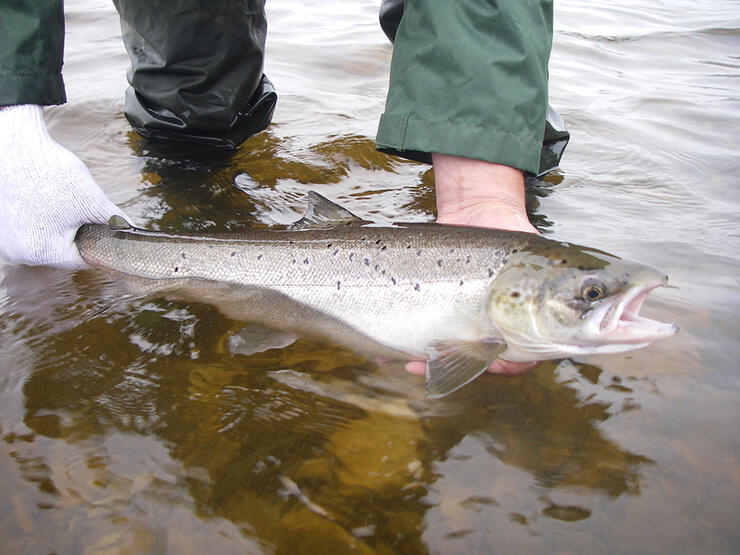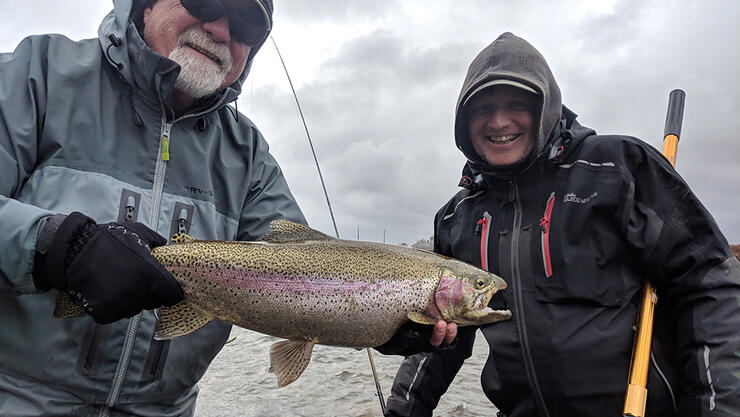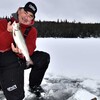
Steelhead and Salmon of Northern Ontario

There is a stretch of highway at the top of the world’s largest freshwater lake that is your avenue to access one of Ontario’s finest fisheries. Highway 17, spanning from Sudbury through Sault Ste. Marie to Thunder Bay has dozens of tributaries of Lake Superior and Lake Huron. These tributaries, at certain times of the year, can be teeming with many species of Pacific salmon, Atlantic salmon, and of course, lake-run rainbow trout (some call them steelhead). They are plentiful, clean and 100% fun to target on the fly, not to mention accessible! Many of the tributaries of these big bodies of water cross underneath the highway, and with a little planning, you can drive to a river, park your vehicle and walk and wade in pursuit of these great gamefish. Conversely, there are a handful of guides that are dialled into the fishery and can put you on fish all season long. Let’s go through the seasons of steelhead and salmon in Northern Ontario.

Weirdly, we’re going to start the calendar year in September… September means salmon in the tributaries of these great rivers, and many of the tributaries support three species of salmon: pink, coho, and the almighty Chinook. The season really starts in the fall for targeting these fish on the fly as they enter the systems to prepare to spawn. Catching pre-spawn salmon is a game of aggression. You need to make them angry to strike at any offer you dish up. Upon entering the system, if they are there to spawn, they stop feeding, so think about streamers, woolly buggers, and other baitfish imitations to entice and eat. Make them mad! You can also drift egg patterns under an indicator for salmon, as they will attempt to remove any eggs that aren’t their own from the system. You’ll want to come well gunned for these fish, especially the Atlantics, coho, and Chinook as they can get quite large, with some chinook pushing 30 and 40 lbs. So, think a minimum of an 8-weight fly rod with a large reel holding lots of backing. Leader and tippet should be as big as you can get away with, as these fish will have developed teeth and can easily cut through lighter tippets. 12 lb fluorocarbon minimum.

For pink salmon, an average fish could push 6 or 7 lbs, so something a little less beefy than a chinook outfit would do just fine in a 6 or 7-weight class rod. Flies for pinks include egg patterns, smaller baitfish patterns such as white zonkers, and nymphs, of course.

The great thing about the salmon moving into the rivers in the fall months is that many species follow them to eat the eggs they drop—some species will even winter over in the tributaries, namely lake-run rainbows or steelhead. They follow the salmon species in and gorge on the eggs as they tumble in the current, and where regulations permit, anglers can target them all winter long. Steelhead outfits should be in the 8-weight range with a floating line for indicator fishing and an intermediate line for any streamers or buggers you might be throwing. Ghost egg patterns, blood dot egg patterns, and egg cluster bombs will be on the menu.

As the winter turns into spring, the steelhead that wintered over in the big lakes start to think about their own spawn. They will start making their way into the rivers to do just that. Once the season opens as per the Ontario regulations, there are great opportunities to fish for both fresh fish in the rivers, non-spawners, or “dropbacks” that have spawned and are feeding up post-spawn to regain their energy for survival in the big lakes. Egg patterns will still work well during this time as well as baitfish and slightly meatier offerings like larger streamers and nymphs such as tarantula stoneflies or Kaufmann stones. But, don’t disregard the staples of prince nymphs, hare’s ears, or copper johns! Equipment can be the same rigs you used for steelhead in the fall.


During the summer months, there are guides in the area that are dialled into resident fish and can help you target local salmonids and rainbows; however, the key seasons of steelhead and salmon in northern Ontario are really the months of late August—November for salmon and steelhead and late April—June for steelhead in the tributaries of the northern-most great lakes. All five species are great adversaries on the fly and will test all levels of any fly angler. The salmon and steelhead of northern Ontario are truly incredible.
Recommended Articles

Why Anglers Are Falling for Golden Lake in Ontario’s Ottawa Valley

Top 5 Baits for Smallmouth and Largemouth Bass

Ideal Christmas Gifts For The Northern Ontario Ice Angler
Awesome Algonquin

Fishing Esnagi Lake

Predicting Lake Thickness
Ontario Brook Trout

’Tis The Season

Hidden Musky Gems

Beaded Lures

Eating Northern Pike

SPECTACULAR BASS
Troutfly Lake Outpost

A Whole Lota Lovin'

Hit The Hard Rock Cafe
Top 5 Musky Destinations in Ontario

3 Great Walleye Lakes

World Class Walleye








